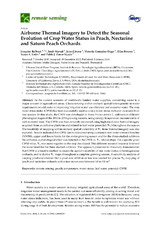Airborne Thermal Imagery to Detect the Seasonal Evolution of Crop Water Status in Peach, Nectarine and Saturn Peach Orchards
Autor
Bellvert, Joaquim
Marsal, Jordi
Girona, Joan
González-Dugo, Victoria
Fereres Castiel, Elías
Ustin, Susan L.
Zarco-Tejada, Pablo J.
Editor
MDPIFecha
2016Materia
Remote sensingPeach
Temperature
Water status
Leaf water potential
CWSI
METS:
Mostrar el registro METSPREMIS:
Mostrar el registro PREMISMetadatos
Mostrar el registro completo del ítemResumen
In the current scenario of worldwide limited water supplies, conserving water is a
major concern in agricultural areas. Characterizing within-orchard spatial heterogeneity in water
requirements would assist in improving irrigation water use efficiency and conserve water. The crop
water stress index (CWSI) has been successfully used as a crop water status indicator in several fruit
tree species. In this study, the CWSI was developed in three Prunus persica L. cultivars at different
phenological stages of the 2012 to 2014 growing seasons, using canopy temperature measurements of
well-watered trees. The CWSI was then remotely estimated using high-resolution thermal imagery
acquired from an airborne platform and related to leaf water potential (YL) throughout the season.
The feasibility of mapping within-orchard spatial variability of YL from thermal imagery was also
explored. Results indicated that CWSI can be calculated using a common non-water-stressed baseline
(NWSB), upper and lower limits for the entire growing season and for the three studied cultivars.
Nevertheless, a phenological effect was detected in the CWSI vs. YL relationships. For a specific given
CWSI value, YL was more negative as the crop developed. This different seasonal response followed
the same trend for the three studied cultivars. The approach presented in this study demonstrated
that CWSI is a feasible method to assess the spatial variability of tree water status in heterogeneous
orchards, and to derive YL maps throughout a complete growing season. A sensitivity analysis of
varying pixel size showed that a pixel size of 0.8 m or less was needed for precise YL mapping of
peach and nectarine orchards with a tree crown area between 3.0 to 5.0 m2

